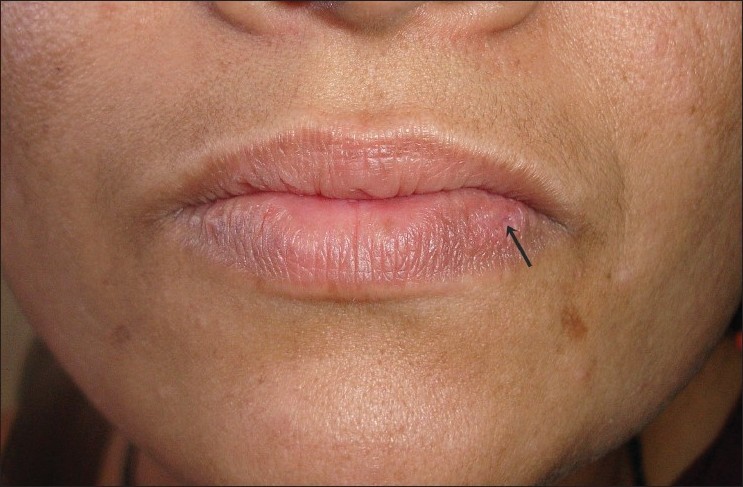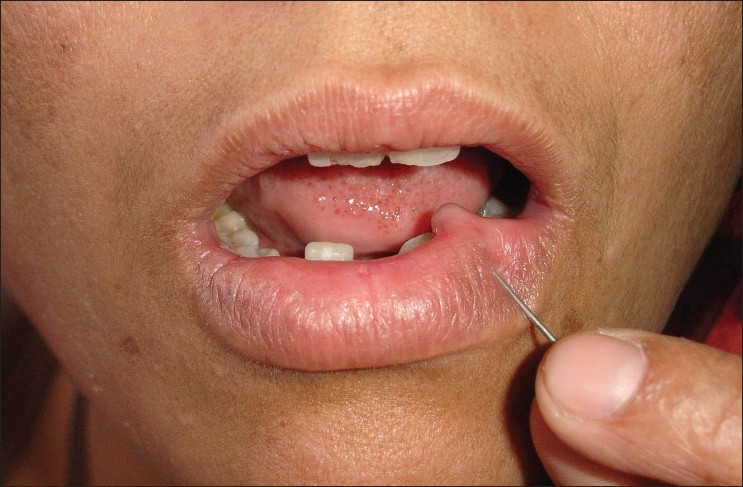Translate this page into:
Solitary lateral lower lip sinus: A rare congenital anomaly
Correspondence Address:
Prashant K Palwade
Keshav Skin and Hair Clinic, Mahesh Nagar, Opposite St. Francis School, Jalna Road, Aurnagabad, Maharashtra - 431 002
India
| How to cite this article: Palwade PK. Solitary lateral lower lip sinus: A rare congenital anomaly. Indian J Dermatol Venereol Leprol 2011;77:403 |
Sir,
Congenital lip sinuses are among the rarest of congenital anomalies. These sinuses are described more commonly in the lower lip and are usually associated with other congenital anomalies of the lip and palate region, that is, cleft lip and / or cleft palate. A solitary lower lip sinus is rarely reported in literature. I report a case of a congenital solitary lateral lower lip sinus, without associated lip and palate anomalies.
A 35-year-old female presented with a pit on the left side of lower lip, since her childhood. She noticed it as a small dimple with an opening at the center. She gave a history of discharge of clear fluid through the pit at times, making the lower lip feel slightly heavier, but it was not related to mastication. There was no history of pus discharge through the pit. On examination a small dimple was seen in the left half of the lower lip, close to the vermillion border, with a central aperture [[Figure - 1]- Arrow]. On probing with a lacrimal probe size 1 - 2, it was 20 mm deep and blind at the end [Figure - 2], and without discharge of fluid or pus during the procedure. There was no history of any facial, lip or palate abnormality at birth in the patient or in any of her relatives. She was diagnosed as a case of congenital solitary lateral lower lip sinus, without any associated anomalies. She was referred to a surgeon for excision of the blind tract. She declined the procedure as the sinus did not cause her that much of a discomfort, for her to undergo an operative procedure.
 |
| Figure 1: A small dimple with a central aperture is seen in the left half of the lower lip, close to the vermillion border (Arrow) |
 |
| Figure 2: On probing the aperture with lacrimal probe size 1 - 2, it was 20 mm deep and blind at the end |
Numerous pathogeneses have been put forward by embryologists to explain the occurrence of these sinuses. It is generally accepted that the sinuses are remnants of the lateral sulci of the lower lip, at the 6.5 to 12.6 mm embryonic stage. [1] These sulci appear as notches on either side of the median groove in the early embryo and usually disappear completely, but in some may persist wholly or partially as lip sinuses. Sinuses usually appear as shallow depressions or slits near the vermillion border of the lower lip. They are often distributed symmetrically being located on each side of the midline. However, atypical locations of sinuses have been described in the midline, the upper lip, and the commisures. The canals always end as blind sacs and are lined by stratified squamous epithelium and numerous mucous secretary glands, whose activity can occasionally be enhanced by mastication. [2]
Most of the reports of lower lip sinuses are associated with cleft lip and / or cleft palate. This association of the lower lip sinus and cleft lip and / or cleft palate is better known as the Van der Woude syndrome (VWS). [3] Isolated lip sinuses have been reported in literature, but the incidence is significantly lower than that where the patient or a member of family has a cleft lip and / or palate. Over 500 cases of lip sinuses are reported in literature and the incidence is 1 : 100000 to 1 : 300,000 in Caucasians. [4]
Taylor and Lane [5] reported that 70 - 80% of the lip sinuses were associated with clefts of lip and / or palate. In the Finnish series, 79 lower lip sinuses were present in 4000 cleft patients, an incidence of 2%. [6] In the same series only two patients had isolated lip sinuses without cleft lip and / or palate in them or in their near relatives. Congenital lower lip sinuses were noted in several members of the same family, leading to the postulate that there was a familial pattern of inheritance, with variable penetrance. These authors also felt that cleft lip and palate and lower lip sinuses might be inherited as a single genetic entity. [7] In a report, a family was traced through four generations, with six members presenting with congenital lip sinuses. Five in this series were male and only one female. Two of the patients had associated clefts of the lip and palate. [8] A recent report of VWS described a child with VWS and his mother having a congenital solitary lateral lower lip sinus. No other member in the family was affected with any lip or palate abnormality. [9] Lower lip pits are characteristic in VWS, popliteal pterygium syndrome, alveolar synechia syndrome, type I orofacial digital syndrome, and ankyloblepharon filiforme adnatum. [10]
The incidence of congenital lip sinuses may be higher than that reported in literature. It is quite possible that lip sinuses are easily missed during the initial neonatal check up, especially in those sinuses with very minimal or insignificant secretary activity. This communication is to make all of us aware of a rare entity, which one should always consider while dealing with disorders of the lip and oral cavity.
| 1. |
Warbrick JG, McIntyre JR, Ferguson GA. Remarks on the etiology of congenital bilateral fistulae of the lower lip. Br J Plast Surg 1952;4:254-62.
[Google Scholar]
|
| 2. |
Iregbulem LM. Congenital lower lip sinuses in Nigerian Children. Br J Plast Surg 1997;50:649-50.
[Google Scholar]
|
| 3. |
van der Woude A. Fistula labi inferioris congenitaand its association with cleft lip and palate. Am J Hum Genet 1954;6:244-56.
[Google Scholar]
|
| 4. |
Cervenka J, Gorlin RJ, Anderson VE. The syndrome of pits of the lower lip and cleft lip and/or palate. Genetic considerations. Am J Hum Genet 1967;19:416-32.
[Google Scholar]
|
| 5. |
Taylor WB, Lane DK. Congenital fistulas of the lower lip. Associations with cleft lip-palate and anomalies of the extremities. Arch Dermatol 1966;94:421-4.
[Google Scholar]
|
| 6. |
Rintala AE, Ranta R. Lower lip sinuses: Epidemiology, microforms and transverse sulci. Br J Plast Surg 1981;34:26-30.
[Google Scholar]
|
| 7. |
Coccia CT, Bixler D. Cleft palate and congenital fistulas of the lower lip: Report of a familial occurrence. Oral Surg Oral Med Oral Pathol 1967;24:246-9.
[Google Scholar]
|
| 8. |
Khanna NN. Congenital lip sinuses. ANZ J Surg 1970;40:184-6.
[Google Scholar]
|
| 9. |
Koçer U, Aksoy HM, Tiftikcioglu YO, Cöloglu H, Karaaslan O. Report of two cases with Van der Woude syndrome: A child and her mother. Genet Couns 2001;12:341-6.
[Google Scholar]
|
| 10. |
Kirzioglu Z, Ertürk MS. Congenital lower lip pits (Van der Woude syndrome): Report of a case. J Contemp Dent Pract 2006;7:134-40.
[Google Scholar]
|
Fulltext Views
2,880
PDF downloads
2,639





